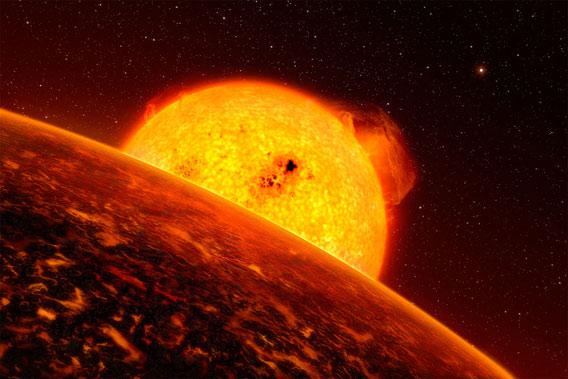Astronomers are finding so many planets orbiting other stars—exoplanets—that records (like smallest, biggest, closest to their star, and so on) fall by the wayside pretty often. Because of that I tend not to report on one record or another that gets broken, unless something truly extraordinary comes up.
Something truly extraordinary has come up. A team of astronomers has reported finding the smallest exoplanet around a Sun-like star yet, and it’s the most diminutive by a long shot: The exoplanet Kepler-37b is a mere 3865 kilometers (2400 miles) in diameter. That’s smaller than Mercury!
Heck, that’s barely bigger than our own Moon, which is 3474 kilometers across. This is a dinky planet.
It was found in data taken by the space-based Kepler observatory, which is staring at more than 150,000 stars all day, every day. If a planet orbits the star, and the orbit of the planet aligns just right, from our viewpoint here at Earth we see the planet pass directly in front of the star. This is called a transit, and when it happens the star’s light dims a little bit. Most of the exoplanets we know of have been found this way.
Not that it’s easy. There are lots of ways the signal can get confused. The light from the star is compared to other stars, and if they change their light (by having planets themselves, or being intrinsically variable) that can look like a planet around the target star. The astronomers accounted for all that, and have a high degree of confidence the tiny planet exists.
The host star, called Kepler-37, is about 200 light years from Earth and is somewhat cooler and smaller than the Sun. In total, three distinct signals from planets were found in the starlight. The other two planets are 0.75 and two times the diameter of the Earth. None of them is what you’d call Earth-like though; even though their parent star is a bit cooler than the Sun they’re so close to it they’re baked. Kepler-37b is the closest, a mere 15 million kilometers (9 million miles) from the star. The second planet (Kepler-37c) is 20 million km (12 million miles) and the biggest of the three (Kepler-37d) is still only 30 million km (18 million miles) out—it has a surface temperature about hot enough to bake cookies.
Kepler-37b is so close to its star it’s definitely scorched and is probably an airless rock; it would have a pretty hard time holding on to any air given how hot the gas would be, and how weak its gravity is.

Image credit: Mercury: NASA/Johns Hopkins University Applied Physics Laboratory/Carnegie Institution of Washington; Kepler-37b art: NASA/JPL-Caltech/T. Pyle; Moon: NASA/Goddard Space Flight Center Scientific Visualization Studio; compiled by Phil Plait
In fact, I wonder if, by our current definition, this even counts as a planet. It’s bigger than Pluto (which is about 2400 km across), but still handily smaller than Mercury. I’m not a big fan of hard and fast definitions for what is or is not a planet, so honestly to me the question of whether or not Kepler-37b is a planet isn’t terribly interesting. What is interesting is what this is telling us about how big (OK, planet-sized) objects form in solar systems. We hadn’t seen anything this small until this one, so it’s at least telling us that bodies smaller than Mercury can form, even closer in to their stars. Since this is the only one detected, we can’t extrapolate too much about how many there are orbiting other stars, but it only takes one to let us know they can.
I want to point out two things about how this planet was found. It was seen in the data by Kepler, but the size of the planet was uncertain because the size of the star was uncertain. You get the planet size by how much light it blocks from the star, but you need the star’s physical size to get that number. In this case, they used a technique called asteroseismology: mapping changes in the star’s brightness as the star physically oscillates, much like using sound waves traveling through the Earth to map its interior. This is a sophisticated technique that can yield very precise measurements of a star’s size, allowing the team of astronomers to get a high degree of certainty for their measurement of the size of Kepler-37b.
The second thing I want to point out is that NASA did not fund the astroseismology work. Get this: The team was, in part, crowd funded! A non-profit group called White Dwarf started the Pale Blue Dot project to raise money to help researchers. They let people “adopt” a Kepler star for a $10 donation, and then used that money to do science. They raised tens of thousands of dollars from this effort, and funded the asteroseismology used to measure Kepler-37b. And look what happened: They found out it was a record-breaking planet!
And yes, before you ask: Kepler-37 was in fact one of the stars adopted, by a user named SERGE.
So congratulations, Serge! It’s a bouncing baby exoplanet.
Tip o’ the Galactus helmet to Travis Metcalfe, who runs White Dwarf.
